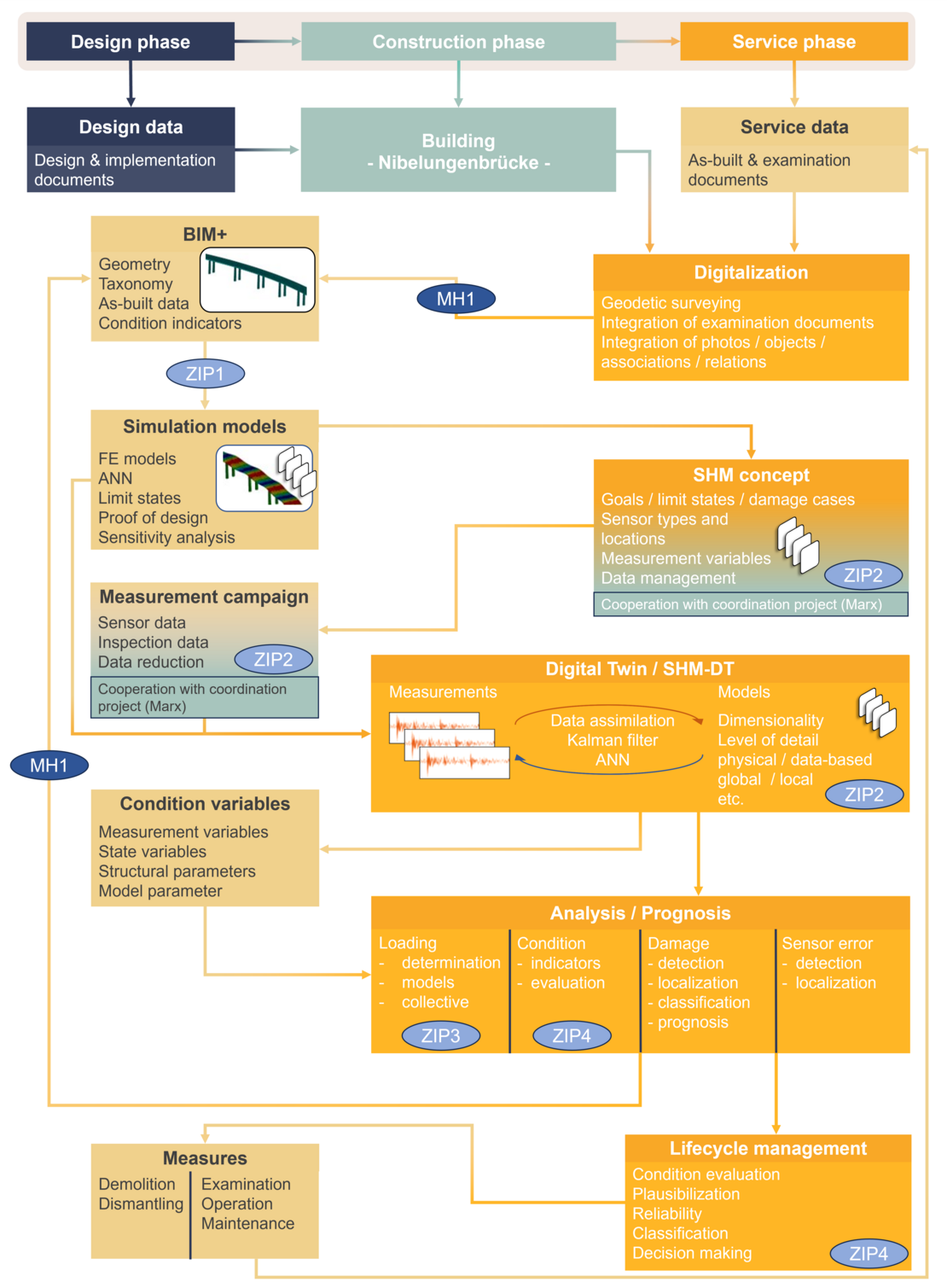LEMOTRA – Lifetime monitoring of structures by means of data assimilation in the digital twin with artificial intelligence
The priority program SPP 2388 "One Hundred Plus – Extending the Service Life of Complex Building Structures through Intelligent Digitalization" aims at the methodological development of an adaptive, intelligent, and digital representation of real buildings to provide predictive building management throughout their entire lifespan. The digital twin of the building is intended to act as the single source of truth for all necessary information and significantly support the practical decisions of building authorities regarding maintenance. The LEMOTRA project is pursuing these objectives systematically and consistently in collaboration with project partners from the SPP. In the first phase, a consistent methodological basis for the digital representation of structures in the form of BIM models and BIM-based FE models of varying complexity, the acquisition of traffic loads from measurement data, and the concept of a digital twin for structural management were developed and tested numerically as well as experimentally using laboratory structures.
In its second funding period the main goal of the LEMOTRA project is the development of practically relevant condition indicators that, based on the recalculation guideline, enable targeted action recommendations. These condition indicators will be derived from monitoring data and comprehensible mechanical models. They will allow the creation of short- and medium-term forecasts of the structure's condition with regard to relevant limit states. Based on this, a decision-making process, a predictive condition assessment, and targeted measures for the maintenance of the structure will be developed. Consequently, an important basis for expanding the recalculation guideline to include action recommendations in phases 3 and 4 can be established and tested using a pilot project. As a prerequisite, the methods developed in the first funding period will be further refined and applied to the Nibelungenbrücke.
The main objective of the LEMOTRA research project for the second funding period is divided into two research priorities and five sub-objectives. Each sub-objective is assigned a corresponding work package.
Research priority: Condition indicators and forecasting models (ZIP)
ZIP1: Development of methods for extracting FE models of varying complexity and dimensionality from the BIM model for the Nibelungenbrücke.
ZIP2: Expansion of the monitoring system and development of the digital twin (DT) for the Nibelungenbrücke.
- ZIP3: Development of methods for the automated determination and forecasting of traffic loads at the Nibelungenbrücke using DT and AI.
ZIP4: Development and testing of practically relevant condition indicators for the Nibelungenbrücke.
Research priority: Methods for the guidelines (MH)
MH1: Development of BIM components for mapping the structural condition in SHM-BIM for the Nibelungenbrücke.
The LEMOTRA project also proposes a holistic concept for the monitoring and condition assessment of real structures, defines interfaces between different subtasks and the relevant data, sets its own methodological research priorities and explains the selected research approaches. This general concept for the lifecycle management of structures is shown in Figure 1.

Team
Publications
Peer-Reviewed Journal Paper
[1] Rudenko, I., Petryna, Y.: An Approach to Automatic Building Information Modeling-Based Generation of Finite Element Models of Different Complexity and Finite Element Dimensionality. Buildings 2025, 15, 171. https://doi.org/10.3390/buildings15020171.
[2] Becks, H., Lippold, L., Winkler, P., Moeller, M., Rohrer, M., Leusmann, T., Anton, D., Sprenger, B., Kähler, P., Rudenko, I., Arcones, D. A., Koutsourelakis, P.-S., Unger, J. F., Weiser, M., Petryna, Y., Schnellenbach-Held, M., Lowke, D., Wessels, H., Lenzen, A.,…Hegger, J. (2024). Neuartige Konzepte für die Zustandsüberwachung und -analyse von Brückenbauwerken – Einblicke in das Forschungsvorhaben SPP100+/Novel Concepts for the Condition Monitoring and Analysis of Bridge Structures – Insights into the SPP100+ Research Project. Bauingenieur, 99(10), 327-338. https://doi.org/10.37544/0005-6650-2024-10-63.
[3] Kähler, P.: Einsatz von Datenassimilationsverfahren für digitale Zwillinge von Tragstrukturen in messtechnischer Strukturüberwachung, Dissertation, Technische Universität Berlin. https://doi.org/10.14279/depositonce-23706.
Conference papers
[1] Kähler, P., Petryna, Y.: Application of artificial neural networks for indirect load measurements on bridges from vibration measurements. In: EWSHM 11th European Workshop on Structural Health Monitoring, Potsdam, Germany (2024). https://doi.org/10.58286/29594.
[2] Kähler, P., Petryna, Y.: Vibration monitoring of structures with indirect load identification and Kalman update. SMAR 2024 – 7th International Conference on Smart Monitoring, Assessment and Rehabilitation of Civil Structures, 4-6. September 2024, Salerno, Italy. Special Issue of Procedia Structural Integrity, SMAR 2024 Proceedings (peer reviewed). https://doi.org/10.1016/j.prostr.2024.09.193.
[3] Rudenko, I., Petryna, Y.: Interaction between BIM and FE models in structural health monitoring. SMAR 2024 – 7th International Conference on Smart Monitoring, Assessment and Rehabilitation of Civil Structures, 4-6. September 2024, Salerno, Italy. Special Issue of Procedia Structural Integrity, SMAR 2024 Proceedings (peer reviewed). https://doi.org/10.1016/j.prostr.2024.09.169.
[4] Rudenko, I.: Kompatibilität von BIM- und FE-Modellen für die Tragwerksanalysen. In: Oesterle, B.; Bögle, A.; Weber, W. et al. (Hrsg.): Berichte der Fachtagung Baustatik – Baupraxis 15. Institut für Baustatik, Technische Universität Hamburg, Hamburg, 2024, S. 75-82.




